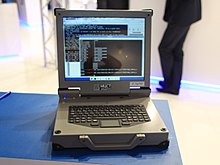MCST
 | |
| Type | Joint-stock company |
|---|---|
| Industry | Microprocessors |
| Founded | 1992 |
| Founder | Boris Babayan |
| Headquarters | , Russia |
| Revenue | $25 million[1] (2017) |
| $1.34 million[1] (2017) | |
| $911,252[1] (2017) | |
| Total assets | $54 million[1] (2017) |
| Total equity | $6.15 million (2017) |
| Website | www |

MCST (Russian: МЦСТ, acronym for Moscow Center of SPARC Technologies) is a Russian microprocessor company that was set up in 1992.[2] Different types of processors made by MCST were used in personal computers, servers and computing systems. MCST develops microprocessors based on two different instruction set architecture (ISA): Elbrus and SPARC. MCST is a direct descendant of the Lebedev Institute of Precision Mechanics and Computer Engineering.[3]
MCST is the base organization of the Department of Informatics and Computer Engineering of the Moscow Institute of Physics and Technology.[4]
MCST develops Elbrus processor architecture and the eponymous family of universal VLIW microprocessors based on it with the participation of . The name "Elbrus" is an acronym for "ExpLicit Basic Resources Utilization Scheduling".
Products[]
- (1973) was the fourth generation Soviet computer, developed by Vsevolod Burtsev. Implements tag-based architecture and ALGOL as system language like the Burroughs large systems. A side development was an update of the 1965 BESM-6 as Elbrus-1K2.
- (1977) was a 10-processor computer, considered the first Soviet supercomputer, with superscalar RISC processors. Re-implementation of the Elbrus 1 architecture with faster ECL chips.
- (1986) was a 16-processor computer developed by Boris Babayan. Differing completely from the architecture of both Elbrus 1 and Elbrus 2, it employed a VLIW architecture.
- (1998–2010) is a computer line based on SPARC instruction set architecture (ISA) microprocessors: MCST R80, R150, R500, R500S, MCST-4R (MCST-R1000) and MCST-R2000 working at 80, 150, 500, 1000 and 2000 MHz.
- (2005) is a two-processor computer based on the Elbrus 2000 microprocessor employing VLIW architecture working at 300 MHz. It is a further development of the Elbrus 3 (1986).
- (2009) is a ccNUMA 4-processor computer based on microprocessor working at 500 MHz.
- Elbrus-2S+ (2011) is a dual-core Elbrus 2000 based microprocessor working at 500 MHz, with capacity to calculate 16 GFlops.
- Elbrus-2SM (2014) is a dual-core Elbrus 2000 based microprocessor working at 300 MHz, with capacity to calculate 9.6 GFlops.
- Elbrus-4S (2014) is a quad-core Elbrus 2000 based microprocessor working at 800 MHz, with capacity to calculate 50 GFlops.
- Elbrus-8S (2014–2015) is an octa-core Elbrus 2000 based microprocessor working at 1300 MHz, with capacity to calculate 250 GFlops.
- Elbrus-8SV (2018) is an octa-core Elbrus 2000 based microprocessor working at 1500 MHz, with capacity to calculate 576 GFlops.
- (2021) is 16-core Elbrus 2000 based microprocessor working at 2000 MHz, with capacity to calculate 750 GFlops at double precision and 1.5 TFlops at single precision operations.
- Elbrus-2S3 (2021) is a dual-core Elbrus 2000 based microprocessor working at 2000 MHz.
See also[]
References[]
- ^ a b c d https://www.kartoteka.ru/card/2da470bb957e47f9ff95c777e6865351/.
- ^ "Russia's microelectronics industry gets steam". East-West Digital News. Retrieved 25 October 2017.
- ^ "О компании/20 лет МЦСТ". 20.mcst.ru. MCST. Retrieved 25 October 2017.
- ^ Department of Informatics and Computer Engineering
External links[]
- Companies established in 1992
- 1992 establishments in Russia
- Computer companies of Russia
- Russian brands
- Companies based in Moscow
- Russian company stubs